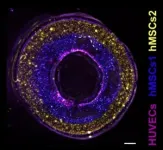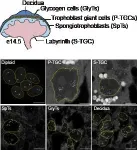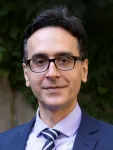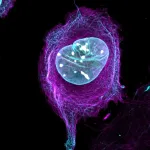Paul Ellison, PhD, receives SNMMI Mars Shot Fund award
2023-06-07
(Press-News.org) Reston, Virginia—The SNMMI Mars Shot Research Fund is excited to announce that Paul Ellison, PhD, assistant professor at the Department of Medical Physics at the University of Wisconsin School of Medicine and Public Health in Madison, has been selected as the recipient of a $500,000 grant from the 2023 Mars Shot Fund. The grants recognize individuals who have made transformative impact in the field and elevated the value of nuclear medicine and molecular imaging.
The grant is one of five awarded in the inaugural year of the new SNMMI Mars Shot Research Fund, which was established to provide resources that translate visionary nuclear medicine imaging, radiopharmaceutical therapy and data science research or projects into tools or treatments that will help improve the lives of patients.
Ellison’s Mars Shot grant was awarded based on his proposal, “Modernizing radiobromine: improved radiohalogenation methodologies for translating 76/77Br theranostics.”
Theranostic radiopharmaceuticals select and stratify patients, quantifying dosimetry from non-invasive positron emission tomography (PET) imaging and delivering treatment with a chemically matched therapeutic analogue. There has been considerable success in labeling larger molecules using a suitable chelating group and appropriate diagnostic or therapeutic radiometal nuclide; however, many small-molecule biological targeting vectors are incompatible with radiometal labeling strategies due to changes in biological activity resulting from the addition of a bulky, charged metal-chelator moiety.
“To fully harness the power of cancer theranostics, there is an urgent need for theranostic pairs of radionuclides appropriate for labeling small molecules that cannot be labeled via radiometal chelation,” Ellison said. “The long-term goal and ‘Mars Shot’ of this work is to develop Br as a true theranostic pair of radionuclides that will rapidly enable development of small molecule cancer theranostics. Proof-of-concept will be demonstrated for norepinephrine transporter avid agents for neuroendocrine tumors, but the technology is also appropriate for labeling radiopharmaceuticals specific to PSMA, FAPI, CXCR4 and the host of new molecular targets that will undoubtedly emerge, accelerating the development of theranostics for other cancers in the future and benefitting a range of industrial and academic researchers.”
Ellison is a medical physicist whose interests utilize the principles and techniques of nuclear and radiochemistry to address challenges in the field of nuclear medicine. As an undergraduate student, he performed research modeling the biokinetic pathways of folding proteins. He pursued his doctorate at the Department of Chemistry, University of California–Berkeley, specializing in nuclear chemistry. As a postdoctoral researcher, he joined the field of medical physics at the University of Wisconsin, becoming heavily involved with the field of medical isotope production and radiochemistry. Since 2020, he has been an assistant professor in the Department of Medical Physics at the University of Wisconsin School of Medicine and Public Health.
“Modernizing radiobromine: improved radiohalogenation methodologies for translating 76/77Br theranostics,” Paul A. Ellison, University of Wisconsin (Principal Investigator); Peter J. H. Scott, University of Michigan (Co-principal Investigator); Melanie S. Sanford, University of Michigan (Co-principal Investigator). Co-Investigators: Jonathan W. Engle, (University of Wisconsin); Allen F. Brooks (University of Michigan).
###
About the SNMMI Mars Shot Research Fund
The ‘Mars Shot for Nuclear Medicine, Molecular Imaging, and Molecularly Targeted Radiopharmaceutical Therapy’ is a forward-looking glimpse into the future of nuclear medicine. Its goal is to provide resources for the translation of visionary nuclear medicine imaging, radiopharmaceutical therapy, and data science research or projects into tools or treatments helping improve the lives of patients.
About the Society of Nuclear Medicine and Molecular Imaging
The Society of Nuclear Medicine and Molecular Imaging (SNMMI) is an international scientific and medical organization dedicated to advancing nuclear medicine and molecular imaging, vital elements of precision medicine that allow diagnosis and treatment to be tailored to individual patients in order to achieve the best possible outcomes.
SNMMI’s members set the standard for molecular imaging and nuclear medicine practice by creating guidelines, sharing information through journals and meetings and leading advocacy on key issues that affect molecular imaging and therapy research and practice. For more information, visit www.snmmi.org.
END
ELSE PRESS RELEASES FROM THIS DATE:
2023-06-07
Reston, Virginia—The SNMMI Mars Shot Research Fund is excited to announce that Amir Iravani, MD, associate professor of radiology in the Department of Radiology at the University of Washington School of Medicine in Seattle, Washington, has been selected as the recipient of a $1,000,000 SNMMI Mars Shot Fund Grant. The grants recognize individuals who have made transformative impact in the field and elevated the value of nuclear medicine and molecular imaging.
The grant is one of five awarded in the inaugural year of the new SNMMI Mars Shot Research Fund, which was established to provide resources that translate visionary nuclear medicine imaging, radiopharmaceutical therapy ...
2023-06-07
Reston, Virginia—The SNMMI Mars Shot Research Fund is excited to announce that Craig Levin, PhD, professor of radiology, physics, electrical engineering and bioengineering at Stanford University in Stanford, California, has been selected as the recipient of a $500,000 grant from the 2023 Mars Shot Fund. The grants recognize individuals who have made transformative impact in the field and elevated the value of nuclear medicine and molecular imaging.
The grant is one of five awarded in the inaugural year of the new SNMMI Mars Shot Research Fund, which was established to provide ...
2023-06-07
Reston, Virginia—The SNMMI Mars Shot Research Fund is excited to announce that Julie Sutcliffe, PhD, professor of internal medicine and biomedical engineering, University of California–Davis, has been selected as the recipient of a $500,000 grant from the 2023 Mars Shot Fund. The grants recognize individuals who have made transformative impact in the field and elevated the value of nuclear medicine and molecular imaging.
The grant is one of five awarded in the inaugural year of the new SNMMI Mars Shot Research Fund, which was established to provide ...
2023-06-07
Reston, Virginia—The SNMMI Mars Shot Research Fund is excited to announce that Randy Yeh, MD, a radiologist and nuclear medicine physician at Memorial Sloan Kettering Cancer Center and assistant professor of radiology at Weill Cornell Medical College in New York, has been selected as the recipient of a $500,000 grant from the 2023 Mars Shot Fund. The grants recognize individuals who have made transformative impact in the field and elevated the value of nuclear medicine and molecular imaging.
The grant is one of five awarded in the inaugural year of the new SNMMI Mars Shot Research Fund, which ...
2023-06-07
KANSAS CITY, MO—June 7, 2023—The placenta, critical for healthy embryo development, is a multi- purpose organ with a precise lifespan—the length of a pregnancy. New research from the Stowers Institute for Medical Research suggests that further exploration of the placenta’s roles and capabilities may one day lead to insights for positive pregnancy outcomes.
The study published in Development on June 6, 2023, focuses on a unique property of many cells comprising the placenta that explains how these cells perform essential functional and physical ...
2023-06-07
More than 5,000 people are diagnosed annually with ALS (amyotrophic lateral sclerosis), a fatal, neurodegenerative disease that attacks nerve cells in the brain and spinal cord, gradually robbing people of the ability to speak, move, eat and breathe.
To date, only a handful of drugs exist to moderately slow its progression. There is no cure.
But CU Boulder researchers have identified a surprising new player in the disease—an ancient, virus-like protein best known, paradoxically, for its essential role in enabling placental development.
The findings ...
2023-06-07
Research Highlights:
58% of adults with Type 2 diabetes covered by Alabama Medicaid did not receive prompt outpatient care after hospitalization for heart failure.
African American and Hispanic adults with Type 2 diabetes were less likely to have post-discharge follow-up health visits, or if they did, the visits occurred nearly two to three days later compared to white adults.
Embargoed until 4 a.m. CT/5 a.m. ET Wednesday, June 7, 2023
DALLAS, June 7, 2023 — More than half of Medicaid-covered adults in Alabama with Type 2 diabetes did not receive follow-up health care within the recommended two-week period following hospitalization for newly-diagnosed heart ...
2023-06-07
The first stars illuminated the Universe during the Cosmic Dawn and put an end to the cosmic "dark ages" that followed the Big Bang. However, the distribution of their mass is one of the great unsolved mysteries of the cosmos.
Numerical simulations of the formation of the first stars estimate that the mass of the first stars reached up to several hundred solar masses. Among them, the first stars with masses between 140 and 260 solar masses ended up as pair-instability supernovae (PISNe). PISNe are quite different from ordinary supernovae (i.e., Type II ...
2023-06-07
TORONTO, CANADA –A new study followed more than 7000 middle aged and older Canadians for approximately three years to understand whether higher rates of social participation were associated with successful aging in later life. They found that those who participated in volunteer work and those participating in recreational activities were more likely to maintain excellent health across the subsequent 3-year study period and less likely to develop physical, cognitive, mental, or emotional problems.
The researchers defined successful aging as freedom from any serious physical, cognitive, mental, or emotional conditions ...
2023-06-07
Certain crops, like greenhouse tomatoes, eggplant, peppers, and blueberries, rely on bumblebees for a style of pollination that only bumblebees can perform. Among growers, the preference can be for bigger-bodied bumblebees because they’re thought to be more efficient pollinators.
Enabled by a $750,000 grant from the National Institute of Food and Agriculture, the research team will investigate factors suspected of influencing bumblebee biology and body size, including climate change, wildfires, and the ...
LAST 30 PRESS RELEASES:
[Press-News.org] Paul Ellison, PhD, receives SNMMI Mars Shot Fund award









